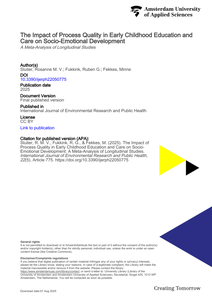We investigated the relationship between process quality in early childhood education and care (ECEC) and children’s socio-emotional development in a meta-analysis of longitudinal studies. Our multi-level meta-analysis of 31 publications reporting on 16 longitudinal studies (N = 17,913 children, age: 2.5–18 yrs) demonstrates that the process quality of ECEC is a small but significant predictor of children’s socio-emotional development over time (ES = 0.103, SE = 0.026, p < 0.001, 95% CI: 0.052–0.155). This longitudinal association extends to the age of 18 years in our sample. Process quality of ECEC is, thus, a significant and stable predictor of children’s socio-emotional development and well-being from toddlerhood to adolescence. The longitudinal relationship was moderated by the type of care (center-based vs. home-based) and the informant (parent, professional caregiver, external assessor, or self-report of the child). Implications for future ECEC research are discussed.
MULTIFILE

In honours programmes, teachers face the task of designing courses in which students feel challenged and learn from accomplishing demanding assignments. The aim of this study was to investigate students’ and teachers’ perceptions of challenge and learning in an honours programme. From 2016 to 2019, students and teachers rated the learning activities during the programme and explained their ratings. The results showed that in the first two years, teachers estimated challenge and learning significantly higher than the students did. However, both students and teachers viewed the tasks as the factor with the strongest impact on challenge and learning. In the first year, students also identified group dynamics as challenging and a source for learning. Enhancing task complexity and supporting group dynamics are the main factors to adjust the level of challenge in an honours programme. Monitoring students’ and teachers’ perceptions can help to adapt the programme to improve students’ learning.
MULTIFILE

Background: The Strengths and Difficulties Questionnaire (SDQ) is widely used to screen for psychosocial problems among adolescents. As the severity of such problems is known to be related to age and gender, screening could be improved by interpreting SDQ scale scores with age-specific and perhaps gender-specific norms. Up to now, such norms are lacking. The aim of the current study is to present gender-specific and joint normative data per year of age for the Dutch self-reported and parent-reported SDQ versions for use among 12- to 17-year-old adolescents. Methods: The norm groups for the self-reported and parent-reported SDQ versions consisted of 993 adolescents and 736 parents, respectively, from the general Dutch population. Per SDQ version, both gender-specific norms and joint norms (percentiles and cutoffs) per year of age were calculated through regression-based norming (Rigby in J Roy Stat Soc Ser C 54:507, 2005). Additionally, these norms were compared to the widely used British norms that are neither age-specific nor gender-specific. Results: By design, gender-specific ‘abnormal’ cutoffs (i.e., cutoffs aimed at identifying max. 10% of the most extremely scoring males and max. 10% of the most extremely scoring females) resulted in about equal percentages of ‘abnormal’ scoring male and female adolescents per SDQ scale. In contrast, joint ‘abnormal’ cutoffs (i.e., cutoffs aimed at identifying max. 10% of the most extremely scoring adolescents) resulted in relatively more male (7.6 to 13.6%, depending on age) than female (3.3 to 8.9%, depending on age) adolescents as scoring ‘abnormal’ on scales measuring externalizing behavior (self-reported and parent-reported SDQ versions), and relatively more female (3.9 to 14.3%, depending on age) than male (1.8 to 6.9%, depending on age) adolescents as scoring ‘abnormal’ on scales measuring internalizing behavior (self-reported SDQ version). In both types of norms, minor age effects were present. Among Dutch adolescents, the British norms yielded detection rates much lower than the expected 10%. Conclusions: Our findings indicate that detection rates depend on the reference group that is used (British or Dutch general adolescent population; specific gender group or not). The normative data in this paper facilitate the comparison of an adolescent’s scores to different reference groups, and allow for cross-country/cultural comparisons of adolescents’ psychosocial behavior.
DOCUMENT